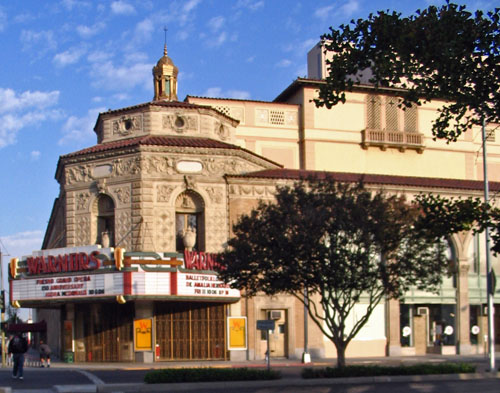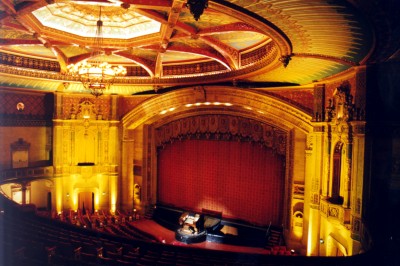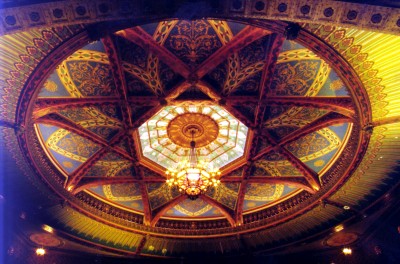
Pantages Theatre (1929)
1400 Fulton Street
B. Marcus Priteca, Architect
Moorish
Revival
Description
The Pantages (Warnors) Theatre, located at Fulton and Tuolumne Streets in downtown Fresno, is an eclectic blend of Moorish, Spanish and Italian Renaissance Revival elements. The base of the store fronts along both sidewalk elevations contain terra cotta detailing. Terra cotta also is used for the fluted pilasters that support the two-story window arcade above the base portion. Above the window arcade is a facade of variegated colored brick from the spring line of the arches resting on the terra cotta pilasters. Above the brick rests a terra cotta entablature that includes a red tile roof. A sectional view through the entablature reveals an approximate two-foot overhang supported by several ogee sections that terminate in a dentil course and bead molding. Each flanking elevation along the main streets radiates from the corner, the location of a partial octagonal rusticated tower. The original marque was suspended at soffit height about two feet out from the corner tower. For emphasis, the tower incorporates rustication in terra cotta to simulate cut stonework with mitered masory joints. Further rustication in the tower includes arch-shaped windows emphasized with a spandrel and side panels heavily enriched with Spanish geometic cartwheel motifs and organic ornament. The tower is terminated with a lantern and cupola, each roofed in the same red tile as above the walls of the main elevations.
The two-story window arcade is set out in front of the main auditorium construction, which rises over thirty feet above the arcade and is set back to appear like a Spanish villa inside a courtyard. The villa type composition of the main auditorium involves corners articulated with terra cotta quoins, terra cotta pilasters, red terra cotta roof lines and arch type windows supported from balustraded balconies.
 The
interior of the main auditorum is approximately a square plan with the volume
of the rooms captured under a single ceiling dome. The dome is flattened and
supported on intersecting flattened arch ribs, which in turn support a center
octagon from which a wrought iron chandelier is suspended. All beams, as well
as the edge of the flattened dome are highlighted through cove lighting around
the dome.
The
interior of the main auditorum is approximately a square plan with the volume
of the rooms captured under a single ceiling dome. The dome is flattened and
supported on intersecting flattened arch ribs, which in turn support a center
octagon from which a wrought iron chandelier is suspended. All beams, as well
as the edge of the flattened dome are highlighted through cove lighting around
the dome.
 Interior wall compositions are created
through the vertical and horizontal division of the wall into panels. Pilasters
define the main division between the anti-proscenium and main auditorium walls.
A painted high wall frieze matches the ceiling ornamentation colors and
consists of painted stencil work bearing geometric patterns between relief
enrichment in the plaster. Between the perimeter of the main ceiling and the
spring of the center dome, plaster enrichment highlighted in gold leaf provides
panels from which are suspended small light fixtures.
Interior wall compositions are created
through the vertical and horizontal division of the wall into panels. Pilasters
define the main division between the anti-proscenium and main auditorium walls.
A painted high wall frieze matches the ceiling ornamentation colors and
consists of painted stencil work bearing geometric patterns between relief
enrichment in the plaster. Between the perimeter of the main ceiling and the
spring of the center dome, plaster enrichment highlighted in gold leaf provides
panels from which are suspended small light fixtures.
Visually supporting the balcony and side exits, while creating a side aisle arcade, are a series of arches executed in plaster on the inside edge of the aisle adjacent to the ends of the seat rows. This "side aisle effect" is a common stylistic element in Spanish Revival architecture.
The proscenium arch frames the opening with a rope molding and wrought iron grating effect. Flanking the arch on each side are large "travertine-effect" pilasters, which support a braid corbeled arch. The anti-proscenium is proportioned as a travertine wall with an ornamental portal.
A significant feature of the theater is its unique pipe organ. Built by the Robert Morton Organ Company of Van Nuys, California, it was installed in 1929. It has fourteen ranks and 1,035 pipes. Its four-manual console contains 720 keys, pedals and combination pistons. Only a few of its kind were made, and it is the only one with its particular specifications and voicings in existence today.
With the exception of the addition of a new marque, the theater retains its original appearance to high degree.
Historical significance
The Pantages Theatre opened in 1928. It was constructed by Alexander Pantages, one of the most prominent managers of vaudeville entertainment and a renowned theater magnate. An immigrant from Greece, Pantages came to the United States and later spent time in the Yukon. He brought the money earned working as a bartender and providing entertainment for the miners back to Seattle, where Pantages purchased his first theater. Before he retired, he owned sixteen large theaters outright and controlled forty more. All of the houses owned or operated by Pantages were designed by architect B. Marcus Priteca. Pantages personally directed the entire chain, including acquisition, building construction and operation of amusements presented. He was familiar with every vaudeville act booked on the entire circuit.
In 1929 the theater was purchased by Warner Brothers, and its name changed to "Warner's Theatre." Fresno thus became the second West Coast city to have a Warner Brother's motion picture theater. The theater was used primarily for motion pictures until 1973, when it was sold to the present owners. Since that time it has been used mainly for concerts. Its name was changed to "Warnors Theatre" in the 1960s.
Adapted from the National Register of Historic Places nomination, originally prepared by Rose Caglia.
Interior photographs ©Mike Caetano. Used by permission.